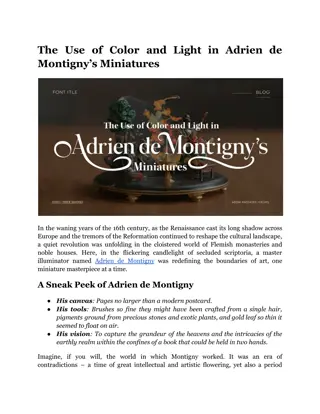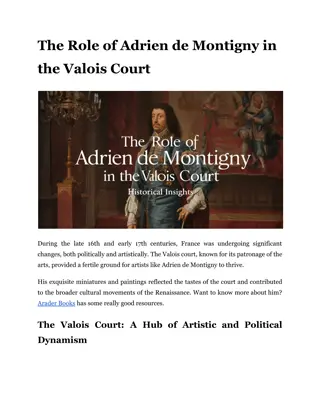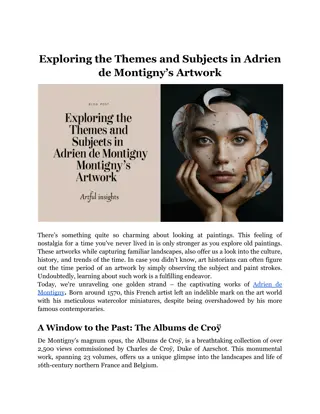
The Commissioning of Adrien de Montigny: Patronage and Artistic Freedom
Explore how Adrien de Montigny's art flourished under patronage, balancing creativity and commissioned work.n
Download Presentation

Please find below an Image/Link to download the presentation.
The content on the website is provided AS IS for your information and personal use only. It may not be sold, licensed, or shared on other websites without obtaining consent from the author. If you encounter any issues during the download, it is possible that the publisher has removed the file from their server.
You are allowed to download the files provided on this website for personal or commercial use, subject to the condition that they are used lawfully. All files are the property of their respective owners.
The content on the website is provided AS IS for your information and personal use only. It may not be sold, licensed, or shared on other websites without obtaining consent from the author.
E N D
Presentation Transcript
The Commissioning of Adrien de Montigny: Patronage and Artistic Freedom In the opulent halls of 16th-century Europe, art was more than mere decoration it was a silent language of power and prestige. A single painting could elevate a nobleman's status or immortalize a family's legacy, transforming canvas and pigment into a tangible form of influence. This was the world of Adrien de Montigny, a talented French artist whose brushstrokes did more than create images; they wove intricate tales of nobility, wealth, and ambition. During this era, commissioning art was a strategic move in the grand chess game of social and political ascendancy. A well-executed portrait could transform a minor lord into a figure of importance, while a series of grand estate paintings could showcase a family's vast holdings, silently boasting of their power to all who beheld them. Montigny found himself at the heart of this artistic alchemy, his talent sought after by those who understood the true value of art in shaping perceptions and cementing legacies. Who was Adrien de Montigny? Adrien de Montigny was a French artist who lived and worked in the late 16th and early 17th centuries. He was known for his detailed and colorful illustrations, particularly
those depicting the castles and estates of his patrons. Montigny's work provides us with a unique glimpse into the lives of the nobility during this period. Understanding Patronage in Art To truly appreciate Montigny's story, we need to understand what patronage meant in the art world of his time. Patronage was a system where wealthy individuals or institutions would support artists financially, providing them with the means to create their work. In return, the patrons would often have a say in what the artist produced. Here's a simple breakdown of the patronage system: Patron's Role Artist's Role Provide financial support Create artworks Offer protection Follow the patron's wishes Determine subject matter Showcase patron's status Promote the artist Develop unique style Read More Article: The Role of Adrien de Montigny in the Valois Court The Powerful Patron: Charles de Croy In Montigny's case, his most important patron was Charles de Croy, the Duke of Arschot. Charles was a powerful nobleman who owned many castles and estates across the Low Countries (today's Belgium, Netherlands, and parts of northern France). He commissioned Montigny to create a series of detailed illustrations of his properties, which would become the artist's most famous work. The Commission: A Monumental Task Charles de Croy's commission was no small feat. He wanted Montigny to create detailed, colorful illustrations of all his properties, including the buildings, gardens, and surrounding landscapes. This project, which would become known as the "Albums de Croy," was a massive undertaking that would occupy much of Montigny's career.
Artistic Freedom Vs. Patron's Wishes While the patronage system provided Montigny with financial stability and the opportunity to create on a grand scale, it also came with certain limitations. The artist had to balance his own creative vision with the desires of his patron. This delicate dance between artistic freedom and meeting the patron's expectations was a common challenge for artists of the time. For Montigny, this meant: Accuracy: He had to portray Charles de Croy's properties with precise detail. Flattery: The illustrations needed to showcase the Duke's wealth and power. Artistic touch: Within these constraints, Montigny still found ways to express his unique style. Image idea: A side-by-side comparison of one of Montigny's illustrations with a modern photograph of the same location, highlighting the accuracy of his work. The Impact of Patronage on Montigny's Style Montigny's work for Charles de Croy had a significant impact on his artistic style. The need for accuracy in depicting the Duke's properties led Montigny to develop meticulous attention to detail. His illustrations are known for their precise architectural renderings and vibrant use of color. However, the constraints of the commission also meant that Montigny's work focused primarily on landscapes and buildings, rather than people or historical scenes. This specialization became a defining characteristic of his artistic legacy. The Legacy of the Albums de Croy The Albums de Croy, the collection of illustrations Montigny created for Charles de Croy, stands as a remarkable achievement. These works not only showcase Montigny's artistic skill but also provide valuable historical information about the architecture and landscapes of the Low Countries in the late 16th and early 17th centuries. Image idea: A collage of several of Montigny's illustrations from the Albums de Croy, showing the variety of properties he depicted.
The Broader Context: Patronage in Renaissance Europe Montigny's experience was not unique. The patronage system was widespread across Renaissance Europe, shaping the careers of many famous artists. Let's look at a few examples: Artist Patron Famous Works Michelangelo Pope Julius II Sistine Chapel ceiling Leonardo da Vinci Ludovico Sforza The Last Supper Raphael Pope Leo X Raphael Vatican Rooms in the These relationships, like Montigny's with Charles de Croy, often resulted in some of the most celebrated artworks in history. However, they also came with their own set of challenges and compromises for the artists involved. Read More Article: Top Trends in Private Jet Travel for 2024? The Evolution of Artistic Freedom As we reflect on Montigny's story, it's interesting to consider how the concept of artistic freedom has evolved over time. While the patronage system of the Renaissance period provided crucial support for artists, it also placed certain limitations on their creative expression. In the centuries that followed, artists gradually gained more independence. The rise of the art market, public exhibitions, and new forms of financial support allowed artists to create works based more on their own vision rather than the direct demands of a patron. Lessons from Montigny's Experience Adrien de Montigny's story offers several valuable lessons: The importance of financial support in enabling artistic creation The potential for constraints to shape an artist's style in unique ways The value of detailed artistic records in preserving historical information The complex relationship between art, power, and wealth in shaping cultural heritage
The Power of Art in Shaping Legacies Adrien de Montigny's journey as an artist under the patronage of Charles de Croy offers a fascinating window into the world of Renaissance art. His story reminds us that great art often emerges from a delicate balance between creative vision and external demands. The Albums de Croy stands as a testament to Montigny's skill and dedication, as well as the profound impact that patronage can have on artistic production and historical documentation. See the captivating world of Renaissance art and patronage with Arader Books' exclusive collection on Adrien de Montigny and the Albums de Croy. It offers rare insights into this remarkable artist's life and work, beautifully preserved in spectacular reproductions and scholarly texts. Whether you're a seasoned art historian or a curious newcomer, our books provide an unparalleled journey into the intricate relationship between artists and their patrons in 16th-century Europe. Site Article: The Commissioning of Adrien de Montigny: Patronage and Artistic Freedom






















